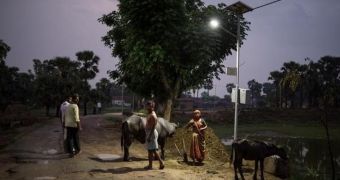When they are not busy protesting nuclear power, drilling in the Arctic, or palm oil linked to deforestation, Greenpeace members and supporters like to spend their time promoting the use of clean energy around the globe.
Thus, not too long ago, the organization got to work on building a solar-powered micro-grid in a remote part of India. The grid is now complete and more than capable of meeting the energy demands of the village of Dharnai.
In a press release issued this July 20, the environmental group explains that, prior to the construction of this micro-grid, said village in the state of Bihar in northern India went about 3 decades without proper access to electricity.
The good news is that, thanks to the organization and its work, the village's residents need no longer worry about not being able to carry on with their daily routine simply because they lack the electricity needed to perform various tasks.
Information shared with the public says that the micro-grid set up by Greenpeace in the village of Dharhai in India has an energy generating capacity of 100 kilowatts and powers 450 homes, 50 commercial operations, and two schools.
Despite the fact that it runs on solar, the 100-kilowatt system also has the capacity to meet the electricity demands of a training center and a health care facility. To ensure locals will never go without energy, a battery is at the ready, should the system fail.
“The solar micro-grid supplies the electricity for homes, street lighting for roads and lanes, and water pumps. Household lighting, agriculture, business activity and social infrastructures like schools, and health centers all have guaranteed electricity,” Greenpeace writes.
“Reliable electricity in the evening has improved educational opportunities for village children, and brought the safety of street lighting. A dependable power supply has boosted the local economy, and brought a welcome improvement to the social life of the villagers,” it adds.
Interestingly enough, Greenpeace says that, following its building this clean energy generating system in the village of Dharnai, several other communities in the region are looking into the possibility to go solar and never again worry about electricity availability.
“The better quality of life of Dharnai residents has become the talk of neighboring villages, all eager to understand and replicate the Dharnai model. The story of the Greenpeace micro-grid project inspiring,” the organization says.
Furthermore, “It is unbelievable to see an entire village lit-up by solar energy. It illustrates how, in a country like India, universal energy access can be achieved without compromising the environment with coal pollution.”

 14 DAY TRIAL //
14 DAY TRIAL //